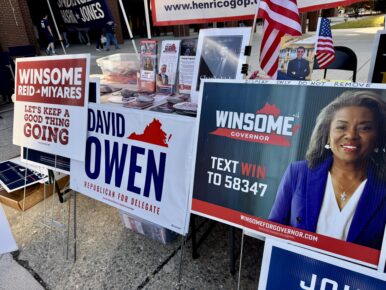Summary
- Spanberger and Earle-Sears face off in Virginia’s historic governor‘s race.
- Winner will be the first woman to lead the commonwealth.
- Earle-Sears would also be the first Black woman elected governor in any state.
- Election seen as key test of Trump-era politics and party strategies.
See updated story: Abigail Spanberger elected
RICHMOND, Va. (AP) — Virginia voters are deciding a history-making race for governor Tuesday that will serve as a barometer of attitudes toward President Donald Trump and Democrats’ attempts to regain their footing on the national stage.
Republican Winsome Earle-Sears, a staunch conservative who serves as Virginia’s lieutenant governor, and Democrat Abigail Spanberger, a center-left Democrat and former CIA case officer who helped her party win a House majority during Trump’s first presidency, are vying to become the first-ever woman to lead the commonwealth. Earle-Sears also would make history as the first Black woman elected governor in any state.
The race to replace term-limited Republican Gov. Glenn Youngkin has taken on national dimensions from the start, serving as a testing ground for both parties one year ahead of national midterm elections that could redirect the country’s course for the balance of Trump’s second term. It comes as the state Trump lost in three successive presidential contests has been strained by many of his policies, particularly the steep cuts to the civil service and the ongoing government shutdown.
For Republicans, Earle-Sears will show whether a candidate in Trump’s general mold — though notably without his full-throated support — can win in a battleground state. For Democrats, Spanberger will signal whether the same center-left approach that worked across the country in the 2018 midterms is the answer in 2026, when the party’s energy has been focused on its progressive base.
“With the political turmoil coming out of Washington right now, this election is an opportunity,” Spanberger said on her final campaign swing heading into Election Day. “Virginia voters can and will send a message amid the recklessness and the heartlessness coming out of Washington.”
Republicans have placed similarly dire stakes on the outcome. “Abigail Spanberger represents the darkness,” Earle-Sears told supporters last weekend.
Spanberger, who gave up her congressional seat to run for governor, has tried to leverage voter concerns about the cost of living and the impacts of Trump’s domestic policy and tax cut law on Virginia’s health care system. She spent millions on television and digital ads tying Earle-Sears to the president, but shied away from Democrats’ 2024 dire warnings about democracy that proved not to be persuasive to voters.
Stephanie Uhl was voting at the Aurora Hills Library in Arlington, with the federal government shutdown on her mind.
The 38-year-old was working without pay for the Defense Department and, though she said, “I can afford (it) just fine,” she was bothered “that it affects so many other people.”
Uhl said she voted for Spanberger, but not for Democratic candidate for attorney general Jay Jones after learning of violent references he made about Virginia lawmakers in text messages made public last month.
Trump has offered only tepid support for Earle-Sears, who three years ago said she wouldn’t back Trump’s return to the White House before recanting. The president did not campaign for her in-person and did not say her name during his only telephone town hall with her supporters Monday night.
The lieutenant governor, meanwhile, has given Trump high marks overall for his performance, but did not mention him at her crowning Saturday night rally, where Youngkin provided the star power in lieu of the president.
Earle-Sears looked to replicate Trump’s attacks on Democrats on cultural issues like transgender people’s participation in sports, but she spoke less about her career-long opposition to abortion rights — giving Spanberger the opening to emphasize her support for abortion rights in the last Southern state that has not restricted or banned the procedure since the U.S. Supreme Court overturned a national right to abortion services.
Earle-Sears also sought to pressure Spanberger for refusing to withdraw her endorsement of Jay Jones, the Democratic nominee for Virginia attorney general, who faced calls to drop out of the contest earlier this fall after disclosure of text messages he sent in 2022 suggesting the former Republican House speaker get “two bullets to the head.”
That race, the contest to replace Earle-Sears at lieutenant governor and all 100 seats in the state’s Democratic-controlled House of Delegates are on the ballot Tuesday. The Democratic-controlled state Senate will face voters in 2027.



